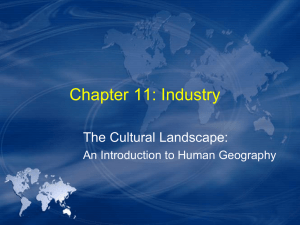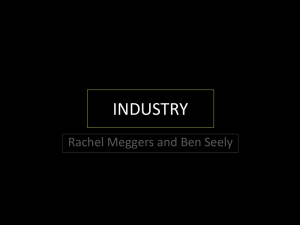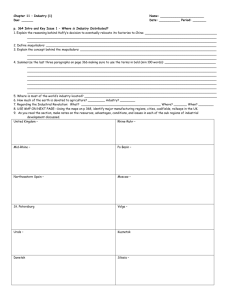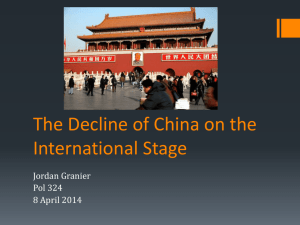Industrialization PP
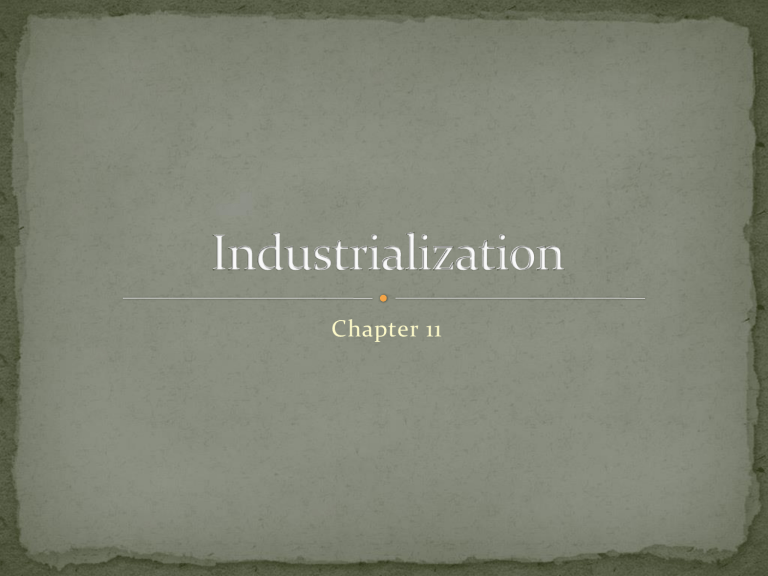
Chapter 11
Figure 11-2
Figure 11-3
Japan—autos, ships, electronics—low wages, sell cheap
China—textiles, steel, household products—in the
1990s, transnational corporations came in b/c China changed its economic policies
#1-Rhine-Ruhr Valley—iron and steel manufacturing because they are near the coal fields
#2-Mid-Rhine—Steel (in Alsace and Loraine) at the largest iron ore field—producing autos and chemicals—Germany is the center of Europe’s most important consumer market
UK used to have steel and textiles, but now it’s high tech industries—Japan has built factories here
Po Basin—textiles—2/3 of Italy’s manufacturing is 1/5 of the land area—hydroelectric power from the Alps
NE Spain—Textiles, autos—FASTEST GROWING AREA
Moscow (fabrics)
St. Petersburg (shipbuilding)
Volga (autos, oil, chemicals)—RUSSIA’S LARGEST
PETROLEUM AND NATURAL GAS FIELDS
Urals (iron, steel, chemicals, machinery)—CONTAINS
MORE THAN 1,000 TYPES OF MINERALS
Silesia (Poland and N. Czech Republic)—steel—E.
Europe’s leading industrial area outside of Russia
Figure 11-4
New England—cotton textiles
Middle Atlantic--#1 market—port for foreign trade
(NYC)
Mohawk Valley—steel and food processing—upper NY
Pittsburg-Lake Erie—steel (Pittsburg to Cleveland)
Western Great Lakes—steel, auto—centered on
Chicago
Southern California—clothing and textile--#1 outside of the NE
SE Ontario—steel and car assembly
Figure 11-5
Figure 11-21
Automobiles (Ford, Gm, Chrysler- Detroit), foreign automakers assemble cars here
Airplanes (Boeing, McDonnell Douglas, Seattle)
Commercial and military
Pharmaceuticals (drugs)
Entertainment (Music Movies- Hollywood)
Computer software (Silicon Valley) TECHNIPOLES
Military weapons
Association of the 5 major emerging national economies due to rapid industrialization
Brazil
Russia
India
China
South Africa
Socioeconomic classifications of countries not yet considered developed countries, but making great strides in industry
Four Asian Dragons—Hong Kong, Singapore, South
Korea, Taiwan
Other NICs—Turkey, Mexico, Argentina, Chile, Egypt
Canada, US, Mexico- NO TARIFFS
Maquidoras : an area set up along Mexico / US border
where factories and industry are set up. It has the benefits of lower wages, lower transportation costs because of closeness to US, lower environmental restrictions, and due to NAFTA no tariffs on goods
Location Theory
•
Location Theory – predicting where a business will or should be located.
•
Location of an industry is dependent on economic, political, cultural features as well as whim.
•
Location Theory Considers:
– Variable costs-energy, transportation costs & labor costs
– Friction of distanceincreasing distance
=increased time & cost
Weber ’ s Model-The Least Cost Theory
Alfred Weber, (1868-1958) a German economists, published Theory of the Location of Industries in 1909. His theory was the industrial equivalent of the Von Thunen Model.
Manufacturing plants will locate where costs are the least.
Three Categories of Costs:
Transportation-the most important cost-usually the best site is where cost to transport raw material and finished product is the lowest
Labor-high labor costs reduce profit-location where there is a supply of cheap, non-union labor may offset transportation costs
Agglomeration- (clustering of an industry) when a group of industries cluster for mutual benefit-shared services, facilities, etc.-costs can be lower
Weber ’ s Theory simplified:
If the raw material is bulkier, the factory will be closer to them, if the finished product is bulkier then the factory will be closer to the markets.
Examples: Coke (Coca Cola) , cars, refrigerators
Proximity to inputs
Bulk-reducing industries
(inputs weigh more than the final product so factories will be located near the raw material)
Examples:
Copper
Steel
Figure 11-8
Why Are Situation Factors Important?
Proximity to markets
Bulk-gaining industries
(industries that gain volume or weight during production)
Examples:
Fabricated metals--cars
Beverage production
Figure 11-10
Single-market manufacturers
manufacturers work near the customers for just-in-time deliveries (ex.-deliver car parts just in time for assembly to avoid storage of bulky items)
Usually have only 1-2 consumers for your factory’s production
(ex.-TG parts go to Toyota in Georgetown)
Perishable products
Ex.-daily newspapers, bread/milk products
Ship, rail, truck, or air?
The farther something is transported, the lower the cost per km/mile
Cost decreases at different rates for each of the four modes
Truck = most often for short-distance travel
Train = used to ship longer distances (1 day +)
Ship = slow, but very low cost per km/mile
Air = most expensive, but very fast
• Break of Bulk Point –
location where transfer among transportation modes is possible
• Seaports and Airports (Baltimore and Louisville)
• Companies that use multiple transport modes locate at a break of bulk point (UPS)
Land
Factories like rural areas b/c they have lots of room for 1-story buildings
Labor
The most important site factor
Labor-intensive industries (when employee wages and benefit costs are high)
Capital
In California’s Silicon Valley-there is a continuation of money being lent from banks for good software ideas
Labor is the main site factor for why locations factors are changing
Attraction of new industrial regions
International shifts in industry
East Asia
South Asia
Latin America
Changing distributions
Outsourcing
Just-in-time delivery rather than keeping a large inventory of components or products, companies keep just what they need for short-term production and new parts are shipped quickly when needed.
Global division of labor corporations can draw from labor around the globe for different parts of production.
( Footloose industry —can be produced anywhere b/c it’s light and cheap to ship)
Relative decline in industrial employment
Automation and
“ runaway shops
”
( an industrial plant moved by its owners from one location to another to escape union labor regulations or state laws)
Reinvestment in higher profit areas
Sunbelt states (non-union)
Semi-periphery and Periphery
In the last 60 years, U. S. manufacturing has shifted from the NE toward the S and W
In the S and W, right-to-work laws encouraged manufacturing by requiring factories to stop “closedshop hiring” and unions so that factories could pay workers less and not have to deal with unions
Collapse of Manufacturing =
Rust Belt
Replaced in
Boston,
Pittsburgh by high-tech industries
In Europe, manufacturing has shifted to the S and E
Internationally, from N. America and Europe to E Asia,
S Asia, and Latin America (ex.-maquiladoras)
2 major industries shifting from MDCs: steel and clothing
Jobs staying in MDCs: jobs for highly skilled workers
International Division of Labor -transfers of jobs, esp. low paid, less skilled workers from MDCs to LDCs
Outsourcing -turning over much of the responsibilities for production to independent suppliers; in vertical integration, company controls all phases of production
• Creative destruction: the process of industrial transformation that accompanies radical innovation.
• So what….
– Deindustrialization in one location suggests that growth is occurring in a separate location
• Capital is not destroyed, it is displaced.
Joseph Schumpeter – the
Father of Creative Destruction
President Reagan – also liked the idea !

